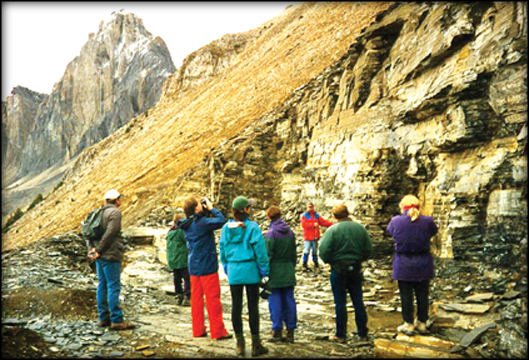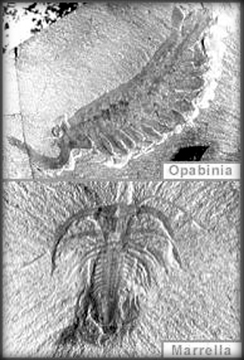Geo Facts

 Scientists
from the universities of Leicester and Cambridge and from the British
Geological Survey have published new research in the journal Geology
this month (November) shedding new light on a 500-million year old
mystery. Scientists
from the universities of Leicester and Cambridge and from the British
Geological Survey have published new research in the journal Geology
this month (November) shedding new light on a 500-million year old
mystery.
The 500 million year-old fossils of the Burgess Shale in Canada,
discovered over a century ago, still provide one of the most remarkable
insights into the dawn of animal life. The beautiful silvery fossils
show the true nature of the life of that time, just after the "Cambrian
explosion" of animal life.
 Yet,
their existence is a paradox (self contradictory but true): the fossils
have been buried deep in the Earth's crust and heated to over 300
degrees Celsius (600 degrees Fahrenheit), before being thrust up by
tectonic forces to form a mountainous ridge in the Rockies. Usually,
such extreme conditions are thought to destroy fossils. But, in the
Burgess Shale, the most exquisite details of soft tissues have been
preserved. Yet,
their existence is a paradox (self contradictory but true): the fossils
have been buried deep in the Earth's crust and heated to over 300
degrees Celsius (600 degrees Fahrenheit), before being thrust up by
tectonic forces to form a mountainous ridge in the Rockies. Usually,
such extreme conditions are thought to destroy fossils. But, in the
Burgess Shale, the most exquisite details of soft tissues have been
preserved.
Now, by careful restudy of its fossils, Alex Page and his colleagues
Phil Wilby, Sarah Gabbott and Jan Zalasiewicz, of the universities of
Cambridge and Leicester and the British Geological Survey, have solved
this riddle.
They have shown that as the delicate organic tissues of these fossils
were heated deep within the Earth, they became the site for mineral
formation. The new minerals, forged at these tremendous depths, picked
out intricate details such as gills, guts and even eyes. Alex Page said:
"This provides a whole new theory for how fossils form. The deep heating
may not have cremated them, but it certainly left them stone baked."
Once an ancient seabed, the Burgess Shale was formed shortly after
life suddenly became more complex and diverse - the so-called Cambrian
explosion - and is of immense scientific interest.
Normally, only hard parts of ancient animals became fossilised; the
bones, teeth or shells. Soft parts were rarely preserved: many plants
and invertebrate animals evolved, lived for millions of years and became
extinct, but left no trace in the fossil record. The Burgess Shale
preserved soft tissue in exquisite detail, and the question of how this
came to happen has troubled scientists since the discovery of the
fossils in 1909.
- ScienceDaily
|
